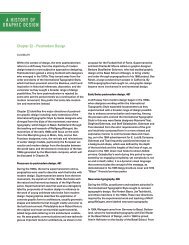Week 2 National Visions within a Global Dialogue - A History of ...
Week 2 National Visions within a Global Dialogue - A History of ...
Week 2 National Visions within a Global Dialogue - A History of ...
You also want an ePaper? Increase the reach of your titles
YUMPU automatically turns print PDFs into web optimized ePapers that Google loves.
A HISTORY OFGRAPHIC DESIGNJapanese designers, Kamekura brought pr<strong>of</strong>essionalismto graphic design in Japan by way <strong>of</strong> his own work,as well as through his leadership in founding the JapanAdvertising Club and, in 1960, with the establishment<strong>of</strong> the Japan Design Center. As managing director <strong>of</strong>the center, he brought graphic designers and industrytogether. Kamekura’s work is characterized by discipline,a thorough understanding <strong>of</strong> printing techniques, geometriccomplexity, and awareness <strong>of</strong> the InternationalTypographic Style, as seen in his poster design for the1970 Osaka World Exposition.In 1958, Tadashi founded the Masuda Tadashi DesignInstitute and combined his interest in photographicillustration with his interest in the collaborative team approach,resulting in new ways <strong>of</strong> seeing and unexpectedsolutions. The work is characterized by the effectiveuse <strong>of</strong> photography and color for communication anda structure <strong>of</strong> fine, ruled lines that contain typographicinformation, as shown in the 1964 Brain magazine coverdesign.Nagai, in his 1984 poster for a Paris exhibition <strong>of</strong> worksby twelve Japanese graphic designers, explores thepotential <strong>of</strong> line and geometric form in which linear elementscombine with scale and color to create a strongsense <strong>of</strong> space. While Nagai focuses on line as a basicdesign element, Tanaka, who opened the Tanaka DesignStudio in 1963, focuses more on plane and shape. InTanaka’s 1981 “Nihon Buyo” No direct translation availablebut the “nihon buyo” is a traditional Japanese type<strong>of</strong> dance poster for the Asian Performing Arts Institute,a traditional theatrical character is presented in Tanaka’svisual language <strong>of</strong> plane and shape, supported by a geometricgrid structure and vibrant, contrasting colors.After graduating from Tama University in 1968, Igarashiearned a degree at the University <strong>of</strong> California, LosAngeles. When he returned to Japan, he opened IgarashiStudio in 1970 after he found Japanese companies unreceptiveto hiring a designer who had spent time abroad.Igarashi is best known for what he calls architecturalalphabets, letterforms drawn on isometric grids, whichhave been used in print, signage, and as three-dimensionalsculpture.Yokoo’s work was influenced less by constructivism andmore by the lack <strong>of</strong> structure and expressive vitality <strong>of</strong>Dada. He was fascinated with mass media, pop art, andcomic books, and their influence found their way into thevisual language <strong>of</strong> his work. The three examples shownin Chapter 23 chronicle the evolution <strong>of</strong> his work fromthe mid-1960s into the 1970s, when his work grew moreuninhibited and he experimented with a range <strong>of</strong> printingtechniques, and into the 1970s and 1980s, when hemoved toward unexpected and even mystical images.Fukuda’s work is characterized by the contradictions<strong>of</strong> Dada and surrealism. He communicates in a visuallanguage <strong>of</strong> simple graphic forms, as in the 1975 poster“Victory 1945,” commemorating the thirtieth anniversary<strong>of</strong> the ending <strong>of</strong> World War II. In this poster, a shell turnsback toward the gun, signifying the folly <strong>of</strong> war. Fukudaalso uses optical illusion, as in the 1975 exhibition posterfor Keio department store, and visual puns, as in theplayful teacups he designed in 1975.Sato opened his own studio in 1970, two years aftergraduating from Tokyo University <strong>of</strong> Art and Music.Metaphysical forms, gradation and glowing color, andcontrast through opposites, such as light and dark,organic and mechanical, and traditional and futuristic,characterize his work. He writes haikus and understandsnonverbal communication in the tradition <strong>of</strong> ZenBuddhism, which teaches the use <strong>of</strong> all five senses inreceiving communication. In his 1984 concert poster“Eclipse Music ’84,” yellow and blue calligraphy vibrateagainst the red ground as an expression <strong>of</strong> the energy <strong>of</strong>the music.Design in the Netherlands, 492The postwar years in the Netherlands were a time <strong>of</strong> rebuildingthe economy and restoring prewar cultural andsocial life. A prevailing atmosphere <strong>of</strong> individuality andfreedom <strong>of</strong> expression created a climate <strong>of</strong> innovation inHolland. As Dutch design evolved, two primary directionsemerged. The first leaned toward modern design,a pragmatic constructivism that built on the Dutch traditions<strong>of</strong> the first half <strong>of</strong> the twentieth century, includingthe influence <strong>of</strong> the De Stijl movement, Piet Zwart, andPaul Schuitema, as well as influences from Switzerland.The Dutch designers discussed in Chapter 23 wh<strong>of</strong>ollowed this approach to graphic design include WimCrouwel, Frisco Kramer, Benno Wissing, Pieter Brattinga,and R. D. E. Oxenaar. The other tendency in graphicdesign that was prevalent during this period was a vigorousexpressionism, which pushed beyond the traditionalvalues <strong>of</strong> harmony, unity, and order toward individualmeaning and subjective expression. The designers inChapter 23 who represent this approach are Jan vanToorn; Anthon Beeke; Ghislain (Gielijn) Dapnis Escher;Gert Dumbar, Bob van Dijk, Dennis Koot, and Studio
















